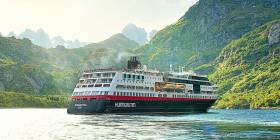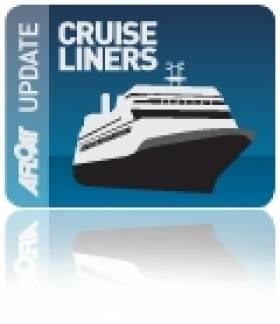Displaying items by tag: Ponant Cruises
#CorkCityCallers – An expedition / coastal cruiseship that trades to both polar regions and a megayacht cruiseship called to Cork City quays this morning, writes Jehan Ashmore.
Norwegian operator Hurtigruten Voyages Midnatsol (midnight sun) which normally plies stunning deep-inland fjords headed up the River Lee to the city’s South Quay. The call to the city-centre is also where Le Soléal, a megayacht from Ponant Cruises docked at North Custom Quay. The 10,000 tonnes cruiseship flagged in the French territory of Wallis and Fortuna Islands, has 132 passenger suites.
It is relatively unusual to have such small cruiseships together in the city-centre, and both having sailed overnight from the same previous port of call. Afloat yesterday monitored the cruiseships at anchorage off Hugh Town, St. Mary’s of the Isles of Scilly.
What is the norm given increasingly larger giant cruiseships that call downriver to Cobh’s deepwater quay. An example been Royal Caribbean International 90,000 tonnes Serenade of the Seas which is arriving this morning from Ponta Delgada, Azores.
Midnatsol’s call to Cork is in advance of resuming the classic Hurtigruten coastal voyages along Norway’s rugged and spectacular coast. The voyage that dates to 1893, involves calling to 34 ports that depart Bergen daily in the south and reach as far north to Kirkenes close to border with Russia.
Prior to sailing to Scilly, Midnatsol had called to Brest, France and before that La Coruña, Spain. This particular cruiseship is part of Hurtigruten’s global ‘Explorer’ voyages that run outside the domestic duties along Norway, however she will rejoin fleetmates from May to September. Since last year, Midnatsol began running expedition cruises to Patagonia and Antarctica.
Of the 12-strong Hurtigruten fleet of passenger, freight and car-carrying vessels, Midnatsol (in which can handle 35 cars), belongs to the largest class of ships, the ‘Millennium’ series. The 16,000 gross tonnage Midnatsol completed in 2003 was built in the Nordic country in Rissa and likewise of her sisters can carry 1,000 passengers.
The sisters are Finnmarken and Trollfjord, the latter made a special promotional port of call to Dun Laoghaire Harbour. This took place early in the career of the ship that berthed at the East Pier from where a visit was made on board the vessel painted in the operator’s distinctive livery of red, black and white.
Small Luxury Cruiseship Visits Killybegs
In 2004 Killybegs received a significant boost in the completion of a €50m outer harbour with berthing quays totalling 350-metres long so to accommodate the north-west fleet and to include the 'supertrawlers'.
Despite the major port infrastructural investment, Killybegs has seen declining fortunes in the fish industry though in recent year's new business from the offshore exploration and cruise ship industries has assisted in generating new revenue.
Cruise-Goers Head for the Galway Races
The vessel first visited Galway in 2009 but this call will be her last year operating under the Spirit of Adventure cruise banner. The company are to replace the vessel next season with the Saga Pearl II which will be transferred from the parent company Saga Cruises and renamed Quest for Adventure.
Prior to the Spirit of Adventurer's call, the 226 passenger Le Diamant arrived from St. Malo last Friday. She became the first vessel to make a call to the 'City of the Tribes' on behalf of her French operators, Cie de Ponant. Her passengers were taken on tours of the city, Connemara and the Aillwee Caves in neighbouring Co. Clare. The vessel is due to return early next month.
With three cruise-calls this year the port is set to increase this figure to 7 in 2012 arising from the ports campaign over the last two years. Paul Carey, Chairman of the Harbour Company, said "We are beginning to see the fruits of this campaign and look forward to growing Galway's association with the return of the majestic passenger liners to Galway".
"The passenger liner The World has been confirmed for a two-day visit in August 2013 which is a great endorsement of Galway as a cruise destination".
The call by the world's first ocean-going luxury resort vessel will also be another first for Galway. Operators of the 43,524gt vessel, Residences at Sea have made previous Irish ports of call to include Dublin, for more on her to the capital last August click HERE.
- Dublin Port
- Galway Bay
- Foynes
- Shannon Estuary
- The World
- Cruiseships
- Ports and Shipping News
- city of the tribes
- Galway Harbour
- Galway Harbour News
- Mutton Island
- Le Diamant
- Cruiseliners
- Saga Cruises
- Spirit of Adventure Cruises
- Spirit of Adventure
- Galway Harbour and Bay news
- Galway Port
- Port of Galway Company
- Ponant Cruises
- Galway Races
- The Galway Races Ballybrit
- Ballybrit Race Course
- Port of Foynes
- Saga Pearl II
- Quest for Adventure
- Shannon Estuary and port news
- The World cruise liner
- Residences at Sea
- The World Residences at Sea
- Irish cruise ports of call
- Irish cruise calls
- Cruiseships to Ireland
- Cruise Companies visiting Ireland
- West of Ireland cruise callers






























































